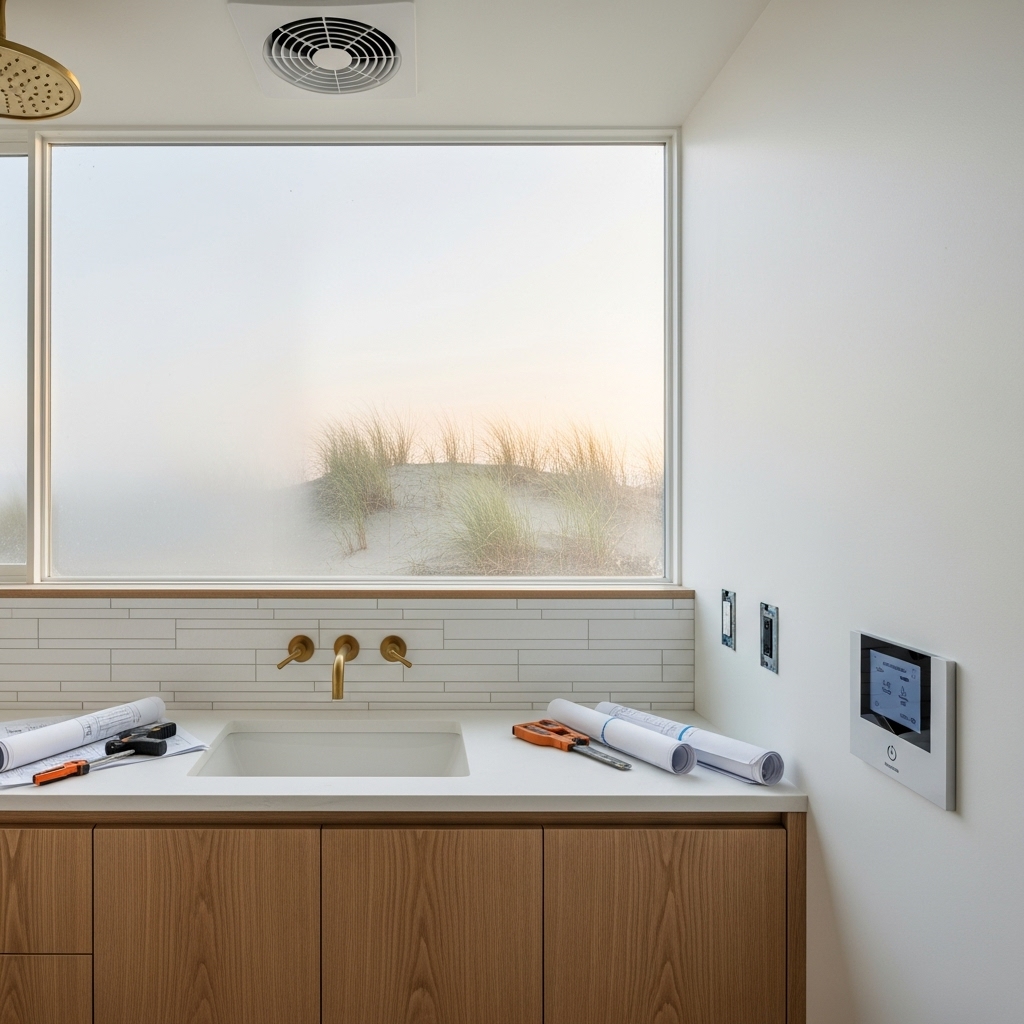Introduction
Planning a local bathroom renovation in Surf City USA requires an approach tailored to the coastal climate, neighborhood styles, and city permitting workflows. This guide explains how to prepare, design, and execute a project that suits Huntington Beach homes, whether you live in a mid-century ranch near Central Park, a townhouse off Beach Boulevard, or a cottage close to the sand. If you are just starting to explore your options, take time to learn about bathroom remodeling best practices so you can confidently map out your scope, timeline, and selections.
Creating a space that stands up to salt air, humidity, and daily use requires thoughtful material choices, airtight waterproofing, and ventilation. The goal is to craft a bathroom that looks beautiful on day one and remains durable and healthy for years.
This guide covers planning essentials, moisture-smart materials, local building considerations, storage solutions for compact coastal homes, and how to collaborate with a contractor for a smooth, predictable build.
Understand the Local Context
Huntington Beach offers a distinctive blend of sun, salt air, and onshore breezes. Those conditions influence how finishes perform and how mechanical systems should be designed. A successful remodel acknowledges the microclimate and typical floor plans found in HB neighborhoods.
- Coastal humidity means prioritize ventilation and vapor control.
- Salt air can tarnish unprotected metals; specify corrosion-resistant hardware.
- Many homes have slab-on-grade foundations; plan plumbing and drainage thoughtfully.
- HOAs in certain communities require submittals for exterior penetrations like new vents.
Local tastes lean toward relaxed coastal elegance: light palettes, organic textures, and finishes that echo the beach without feeling themed. Natural light, airy storage, and easy-clean surfaces are especially valued.
Project Planning Essentials
Begin with clarity around goals, constraints, and expectations. The better you define these elements up front, the smoother construction will go.
- Establish goals: more storage, better lighting, improved ventilation, spa features, or accessibility upgrades.
- Document existing conditions: measure walls, ceiling heights, window sizes, and plumbing locations.
- Define the scope: cosmetic refresh, partial remodel, or full gut with layout changes.
- Create a preliminary schedule: note family events, travel, and seasonal considerations.
- Set decision milestones for fixtures, tile, and lighting to keep sourcing on track.
Think about how you use the space: morning routines, evening wind-downs, children’s baths, or post-beach cleanups. These daily patterns should guide layout and storage priorities.
Moisture Management and Ventilation
Waterproofing is the backbone of a long-lasting bathroom. Huntington Beach’s coastal air increases the importance of managing humidity and vapor migration.
- Use a continuous waterproofing membrane in showers, around tubs, and at any wet wall.
- Slope shower pans correctly and ensure reliable drainage.
- Specify a quiet, properly sized exhaust fan ducted to the exterior with short, straight runs.
- Consider a humidity-sensing fan that automatically regulates moisture levels.
Well-designed ventilation protects finishes, reduces odors, mitigates mold risk, and preserves indoor air quality.
Smart Material Selections for Coastal Homes
Choose materials that balance beauty with durability. In salty, humid air, not all finishes age gracefully.
- Tile: porcelain and dense ceramics offer excellent water resistance and easy maintenance.
- Stone: if using marble or limestone, plan for sealing and gentle cleaners; consider quartzite for greater resilience.
- Metals: opt for solid brass with coastal-grade plating, marine-grade stainless, or powder-coated aluminum.
- Cabinetry: plywood boxes with moisture-resistant finishes outlast particleboard in humid conditions.
- Countertops: porcelain slabs and engineered stone are durable, nonporous, and consistent.
- Glass: low-iron shower glass reduces green tint; specify protectant coatings to ease cleaning.
Pair these with slip-resistant floor tiles, especially important after a beach day, and a grout system designed to repel stains and moisture.
Layout Strategies for Comfort and Flow
Good layouts give each function room to breathe. Consider door swings, clearances, storage access, and view lines.
- Center the vanity on the room’s visual axis to anchor the space.
- Ensure at least one landing zone on the vanity for toiletries and grooming tools.
- Place the toilet out of direct sight from the doorway when possible.
- Use pocket or barn doors to free up floor area in compact baths.
- Reserve a dedicated linen cabinet or tall tower for towels and bulk items.
For small bathrooms, mirrored medicine cabinets and light-reflective finishes expand the feel of the room without compromising storage.
Lighting That Works Day and Night
Layering light provides clarity for tasks and ambiance for relaxation.
- Task lighting: vertical fixtures or sconces at eye level for even facial illumination.
- Ambient lighting: dimmable overheads keep the mood adaptable.
- Accent lighting: toe-kick or niche LEDs add depth and nighttime navigation.
- Daylighting: frosted windows or skylights bring in brightness while maintaining privacy.
Consider warm, coastal-friendly color temperatures that flatter skin tones and complement natural finishes.
Water and Energy Efficiency
Select WaterSense-labeled fixtures, thermostatic valves, and efficient exhaust fans. Pair efficiency with comfort features like warm floors or towel warmers for a spa-like feel without compromising resource stewardship.
Permits and Local Guidelines
Bathroom remodels that involve plumbing, electrical, or structural changes typically require permits. Expect inspections for rough plumbing, electrical, waterproofing, and final sign-off.
- Gather drawings: plan, elevations, and any structural notes.
- Huntington Beach submittal: confirm current requirements on forms and plan sets.
- Inspections: schedule ahead to keep the project moving.
- HOA approvals: submit early if exterior penetrations or window changes are planned.
Working with a contractor familiar with the city’s processes can streamline approvals and inspections.
Storage That Fits Coastal Lifestyles
Beach living introduces sandy towels, sunscreen, and extra toiletries. Design storage to corral it all without clutter.
- Pull-out vanity organizers for small items and heat tools.
- Tall cabinets with adjustable shelves for linens and bulk supplies.
- Niches in showers sized for large bottles and shavers.
- Hooks and towel bars positioned for quick drying.
Thoughtful storage reduces countertop clutter and makes daily routines smoother.
Working With a Contractor
Choose a professional with demonstrated waterproofing expertise, excellent communication, and a clear production schedule. Ask about site protection, dust control, and daily cleanup. Review how change decisions are documented and approved to avoid ambiguity.
- Request local references and see finished bathrooms similar to your goals.
- Verify license, insurance, and safety practices.
- Align on a single point of contact and expected response times.
A good partner will help you refine scope, sequence trades efficiently, and maintain quality control from demo to punch list. When comparing approaches, look for teams that specialize in bathroom remodeling and have repeatable, detail-driven methods for waterproofing and finish work.
Construction Sequence Overview
While every project is unique, most follow a predictable path.
- Protection: cover floors, isolate dust, and set up temporary facilities if needed.
- Demolition: careful removal to protect adjacent spaces and utilities.
- Rough work: plumbing, electrical, framing, and ventilation adjustments.
- Inspection milestones: ensure compliance before closing walls.
- Dry-in: insulation, backer boards, and waterproofing membranes.
- Surfaces: tile, counters, and paint.
- Fixtures: set the toilet, vanity, shower system, and accessories.
- Detailing: silicone, caulk lines, mirror install, and hardware alignment.
- Commissioning: test every valve, drain, fan, and light.
- Closeout: cleaning, tutorials, and warranty handoff.
Maintaining momentum depends on timely decisions, material readiness, and proactive inspection scheduling.
Design Ideas Inspired by Huntington Beach
Blend subtle coastal references with timeless details. Consider soft whites, sandy beiges, foggy grays, and sea-glass accents. Woven textures, white oak, and matte black or brushed nickel metals feel right at home. A vertical stack bond tile evokes modern surf culture; handmade zellige adds artisanal depth evocative of the shoreline.
- Curbless shower with linear drain for clean lines and accessibility.
- Wall-mounted vanity to lighten small rooms and ease cleaning.
- Integrated skylight shaft for daylight without privacy concerns.
- Heated floors for comfort after ocean swims.
Care and Maintenance
Keep your bathroom pristine with a simple routine.
- Use gentle, pH-neutral cleaners to protect sealers and finishes.
- Rinse shower walls and squeegee glass to minimize mineral buildup.
- Inspect caulk and grout annually; repair any hairline gaps promptly.
- Replace fan filters and confirm airflow to manage humidity.
Proactive care preserves beauty and prevents small issues from becoming big ones.
FAQs
Q: How long does a typical bathroom remodel take in Huntington Beach?
A: Scope drives duration. Cosmetic updates can be relatively quick, while full renovations with layout changes, inspections, and custom materials take longer. Planning, early selections, and timely inspections help keep schedules predictable.
Q: What bathroom features perform best near the coast?
A: Porcelain or dense ceramic tile, quartz or porcelain slab counters, brass or stainless hardware, and well-sealed cabinetry excel in salty, humid conditions. A robust exhaust fan is essential.
Q: Do I need a permit for my bathroom remodel?
A: Most projects that involve plumbing, electrical, or structural work require permits and inspections. Your contractor can help prepare plans and schedule city inspections.
Q: How can I maximize a small bathroom?
A: Use wall-mounted vanities, mirrored cabinets, bright surfaces, and integrated niches. Pocket doors and curbless showers reclaim valuable inches.
Q: What about accessibility?
A: Consider wider clearances, blocking for future grab bars, low-threshold or curbless showers, bench seating, and lever handles. Accessible choices can be discreet and stylish.
Q: How important is waterproofing?
A: It is critical. Proper membranes, slope, and detailing protect framing, prevent mold, and extend finish life. Demand a documented waterproofing system from your contractor.
Q: Can I live at home during construction?
A: Many households do, especially when there is a second bathroom. Expect dust protection, daily cleanup, defined work hours, and temporary provisions for water shutoffs.
Ready to Upgrade Your Bathroom?
If you want a space that fits your coastal lifestyle, functions flawlessly, and ages gracefully in salt air, partner with a team experienced in Huntington Beach homes. From scope definition to final detailing, the right experts can guide every step of your bathroom remodeling journey and help you enjoy a smooth, confident transformation.

